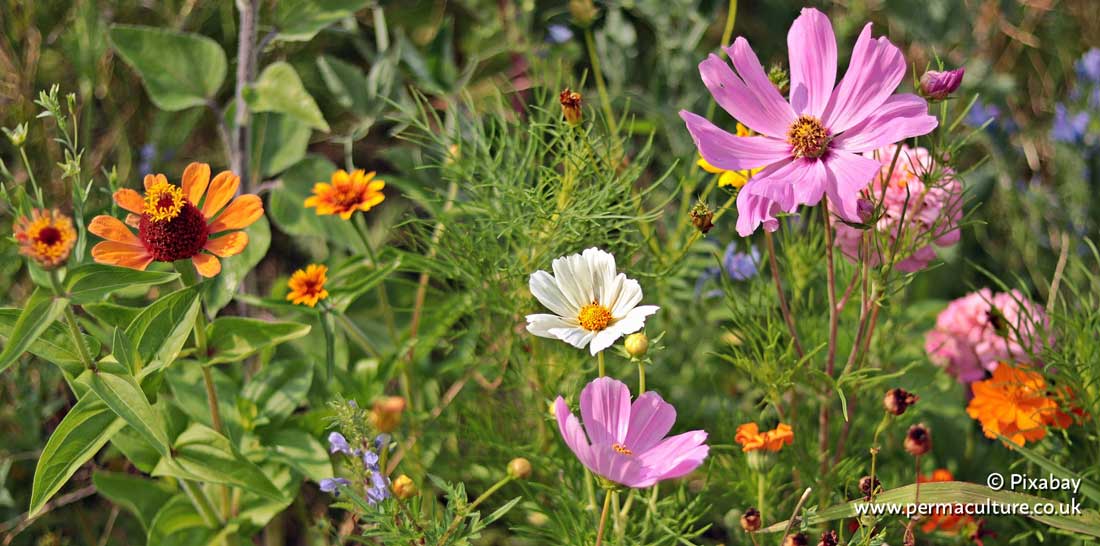The raspberry, with its botanical name Rubus idaeus, belongs to the rose family, which includes around 3,500 species. The raspberry is a hardy, deciduous climbing shrub that come in a variety of colors, including red, purple, yellow or gold and black. The shrub can bear fruit twice a year. The plants are self-pollinating, but wind, bumblebees and bees also help the plant to bear plenty of fruit after flowering. The delicious raspberry bush is one of the rose plants that thrive best in the garden in a sheltered, partially shaded to sunny spot. Due to its natural sweetness, the fine red fruit is often eaten raw as a dessert. But the raspberry is also ideal for preparing jelly, jam, cold bowls and juice.
Raspberries are very easy to grow in almost all climates and soils, raspberries are an ideal plant for gardeners and small farmers across the United States. They are known to grow wild in many areas and without much help. Raspberries fruit year after year and can be harvested all the way from midsummer through to the first frosts. They are very convenient to place in small gardens, since they take up very little space, and only a couple of bushes can provide you with plenty of fresh raspberries to the table. A raspberry bush grows quickly under the right conditions, and despite the plant’s hardiness, a single bush can produce hundreds of delicate berries. This combination of flowering speed and volume makes it the perfect pollen honey that is still rarely found in stores. Raspberry honey has a delicate aroma of flowers and a delicate aroma of raspberries, a very pleasant aroma and great taste. And however, growing raspberries for beginners doesn’t have to be a stressful endeavor. In fact, with proper planting and care, nearly anyone can become a successful raspberries gardener.
Common Name – Raspberry, Wild Red
Scientific Name – Rubus idaeus
Family Name- Rose (Rosaceae)
Flower Color – White
Habitat – Roadsides, thickets
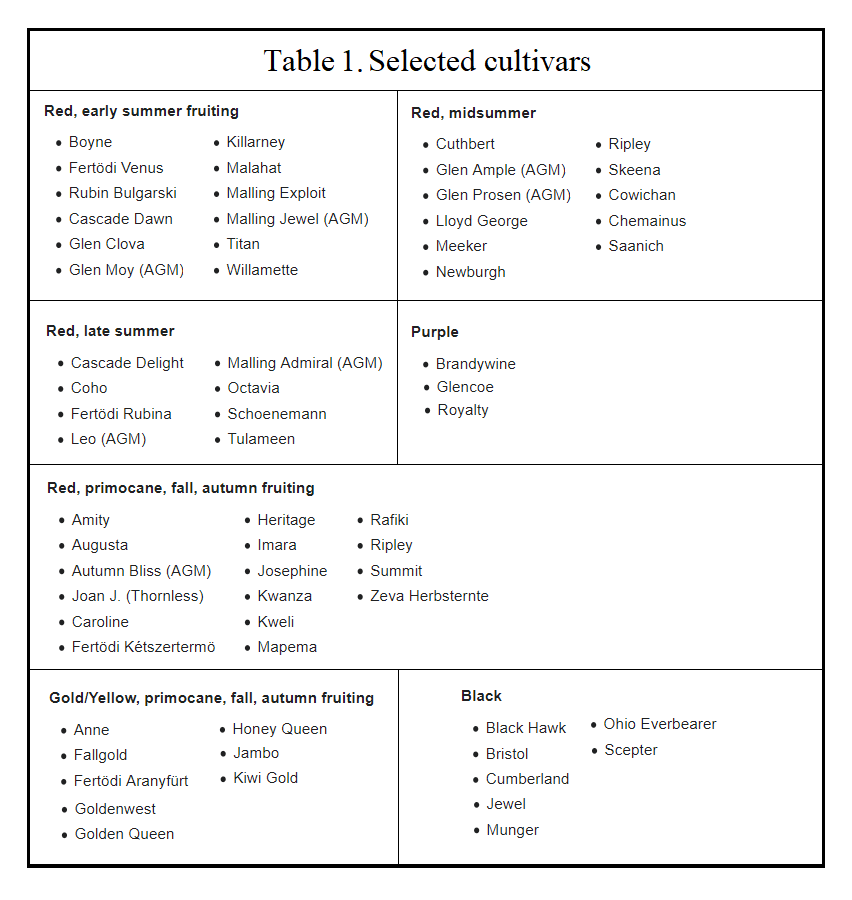
Origin – The raspberry is native to Europe and Asia. The wild species is a forest pioneer plant, that is, it grows in forest clearings, but also on the edges of forests and on rubble sites.
History – The raspberry was cultivated around 400 years ago. The popularity of the raspberry in food and medical uses continued since ancient times when its juice was also used as a red stain in art work. In ancient times people also saw it as food and medicinal plant. It was to be found in large numbers in medieval monastery gardens. The cultivars of the garden raspberry were bred by crossing a European with an American subspecies. In the meantime, various cultivars and American species (Rubus spectabilis and Rubus strigosus) are grown, which are also released into the wild.
The raspberry bush can grow to about two meters in height. The raspberry stem is usually prickly. Its green leaves are serrated. The raspberry flower grows to about one centimeter in size and is normally greenish-white. The berry itself is dark red when ripe. The rods are covered with fine spines. The alternate leaves arranged on the stem axes are petiolate. The imparipinnate leaf blades consist of three, five or seven serrated leaflets. The hermaphroditic flowers are radial symmetry and five-fold with a double flower envelope. The flower base is strongly protruding. There are five sepals. The five free petals are white. The more than 20 stamens are free and fertile. There are free carpels. The fruits, which are red when ripe, and yellow or black when cultivated, are, contrary to what the common name raspberry suggests, botanically speaking not berries, but aggregate drupes that form from the individual carpels. In contrast to the blackberry, the fruit is only loosely attached to the flower base and can be easily peeled off. Depending on the variety, raspberries can be harvested from June until the first frosts in late autumn. Their main odor component is the raspberry ketone.
Growing range – Raspberry is found throughout Asia, western North America and Europe and has a preference for warm southern conditions. According to Wikipedia in 2018, world raspberry production was 870,209 tones, with Russia being the leading producer, accounting for 19% of world production. Other major producers were Mexico, Serbia and Poland, as well as the following (Figure 1.)
Hardiness USDA – Various kinds of raspberries can be cultivated from hardiness zones 3 to 9. Hot, dry, windy weather can damage fruiting canes.
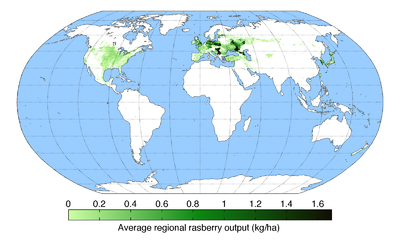
Worldwide raspberry yield – Wikipedia
Climatic limitations – Raspberries are grown in regions across the globe where temperatures during the growing season are around 70-75oF (13-21oC). Although they can grow in regions that are hotter, when temperatures are too high, the process of photosynthesis stops, resulting in poor crop production and may result in a weaker plant during the dormant season.
Soil – The soil is probably the most important factor that determines the success of the raspberry harvest. Raspberries grow best in slightly acidic soil, a pH value of 3.2 – 3.6. However, extremely heavy, compacted soils, in which waterlogging can easily form, are unsuitable. You can improve very loamy soils by incorporating mature compost and coarse sand.
Location – Raspberry plants thrive best in a sunny, sheltered spot in the garden. They appear as a forest pioneer on bare land. It prefers nitrate-rich soils in partially shaded locations, for example in clearings and on the edges of forests with high humidity and cool summer temperatures. Raspberries do not tolerate waterlogging because they are sensitive to root diseases.
Spacing – Raspberry bushes should not be planted too close together. There should still be space between the bushes, this ensures adequate ventilation of the leaves, which prevents plant diseases. It also makes it easier to pick the ripe raspberries at harvest. There should be a minimum of 50cm distance between the plants when planting. If you lay out the bushes in several rows, leave about 1.5 meters between the rows. This will prevent you from compacting the soil directly around the bushes with your feet during harvest and other work on the plants.
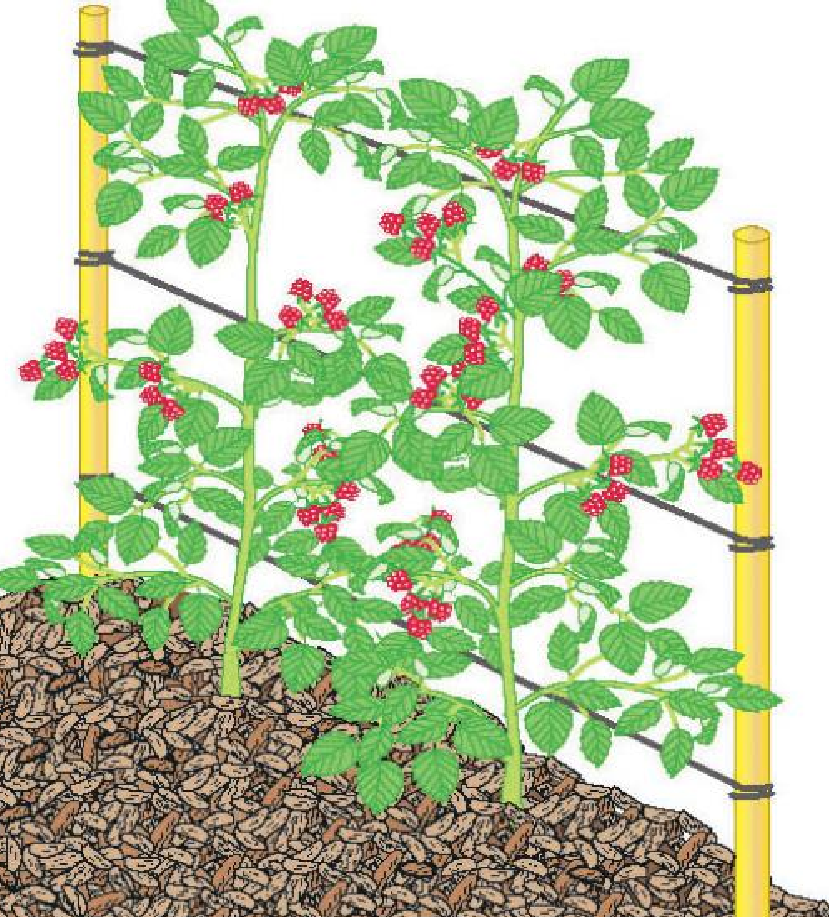
Pollination – Raspberries are primarily self-fertile, but their flowers allow for cross-pollination. Depending on the variety, cross-pollination with pollen from another variety can lead to better development of the fruit tissue, resulting in the formation of a larger fruit. Bees help distribute the pollen evenly across all the stigmas of the flower, which also increases the size and shape of the fruit, even in self-fertile varieties. Since the raspberry is a collective crop, several bee approaches are necessary so that all ovaries are adequately pollinated.
Tests with caged compared to uncaged plants showed that the fruits when honeybees were flying were twice as large as the comparison series without bees.
In the absence of bees, there were 71-82% fewer stone fruits and wind was not a factor in pollination. The weight of the berries increases by approx. 20% in the presence of bees and the number of berries increases by approx. 50%
Only 16-70% of the flowers produce berries when insects have been excluded; compared to 64-98% fruiting when pollinated by insects. In the absence of honey bees, the seed yield can drop by 70-80%. By excluding honeybees as pollinators, there was an annual decrease of 1.5-4.7kg per 15m² or a reduction in yield of 26-42% per hectare, depending on the variety. Honey bees are the main pollinators with a value of over 90%. Due to the mutual benefit of bees and raspberries, these insects should be given the greatest possible attention as pollinators.
Picking the right cultivar – Raspberries come in hundreds of varieties, there are five basic types: red raspberry, yellow raspberry, black raspberry, purple raspberry and everbearing raspberry, of this the red raspberry is most common. Each of the raspberries varieties is distinctive in color, size, flavor, and nutritional composition. Summer raspberries and autumn raspberries differ in terms of care and harvest time. While the summer varieties ripen earlier, the autumn varieties need two months longer. Selected cultivars located on (Table 1.).
Red and yellow raspberries: Yellow raspberries are much like the red raspberries except for their color. They both are extremely sweet to eat raw. Although you can use them as a great ingredient in jams and jellies, pies and tarts.
Black raspberries: While you can enjoy black raspberries fresh, most commercially grown black raspberries are used in specialty foods such as jams and purées or used to make products like dietary supplements and natural food coloring. These varieties like to root from their tip, which means that where a trailing cane touches the ground it can root and start a new plant.
Purple raspberries: are a larger size berry than other raspberry variety. Purple raspberries have a typical raspberry shape and a similar raspberry flavor, but due to their higher sugar content, they are sweeter than red varieties. Purple raspberries will perfectly complement fruit salads, cakes and tarts. The higher sugar content of the purple variety is perfect for jams and jellies. Moreover, its berries retain their intense color through the preservation process.
Everbearing raspberry: is different for its flavor, firmness, and large fruit size. This bush has two harvest seasons with a moderate harvest in July and a high harvest in September before frost. This variety can be consumed fresh, canned or frozen.
Fertility – Raspberries need fertilizer rich in potassium, which also contains small amounts of magnesium. Because raspberries also have high demands on the soil structure, organic fertilizers, which in addition to their nutritional effect also improve the soil, are particularly suitable. It is also important that the raspberries have nutrients available for a long time and that they are not overwhelmed with them at the time of fertilization. This long-term effect is given naturally with organic fertilizers. As organic fertilizer, recommend compost, cattle or pig manure, mulch or mainly organic fertilizer from the trade.
Fertilization is done once at the beginning of the growing season, as soon as the ground is no longer frozen, for example in March. A second time a few weeks or months later – but before the raspberry blossoms – fertilizer is applied.
Mulching – With raspberries, mulching proves to be useful in several ways. The mulch cover keeps the moisture in the soil, ensures a good supply of nutrients by rotting as a fertilizer and keeps the soil loose. Due to the cover, weeds cannot or hardly emerge under the raspberry bushes. This is important because dense weed growth promotes the dreaded rod disease. All materials that are natural and will rot are suitable for mulching. They release nutrients that significantly improve the soil.
Compost – It is very recommended to make a compost. Because compost is the best method to prepare soil for raspberries: the rotting organic waste, grass clippings, leaves and other plant residues not only bring nutrients such as nitrogen, potassium and phosphorus pentoxide into the soil, they also loosen it up. And that is particularly important with raspberries: the plants are sensitive to waterlogging, which means there is a risk of root rot. Heavy, loam and clay soils should be loosened up with a lot of compost. All you have to do is work the ripe compost into the soil with a digging fork. If the ground is very firm, you should also mix in some sand when digging, which also ensures that excess rainwater drains off better.
Irrigation – The raspberry likes it permanently moist. The emphasis here is exclusively on ‘moist’, because watering that is too well-intentioned can quickly lead to waterlogging, which in turn favors rot and other diseases. So, water your raspberries regularly, but not too heavily, when it is dry. A fully grown raspberry bush can, however, tolerate around 10 liters of water every two days in the dry midsummer. Especially during flowering and then when the plant starts to bear fruit until the end of the harvest, do not forget to water it. Too little water while the fruit is ripening allows the delicious fruits to dry out quickly on the bush.
Weeding – Growers should maintain a weed-free area around their raspberry garden by maintaining a couple of feet of soil around the raspberry. This helps prevent perennial weeds from constantly entering raspberry patches through underground rhizomes or through airborne seeds. For a low-maintenance perimeter, gardeners can plant a groundcover in the area to prevent weed growth.
Pruning – Raspberry shoots produce their harvest in their second year of growth. If old shoots are not removed, the crop will become litter and dense over time. Raspberries are pruned in late winter (February), when the vegetation is highly inflamed and the nutrients contained in the wilting shoots have been transferred to the root system. Pruning can also be done in early spring before the start of growth, at the same time removing shoots damaged during the winter.
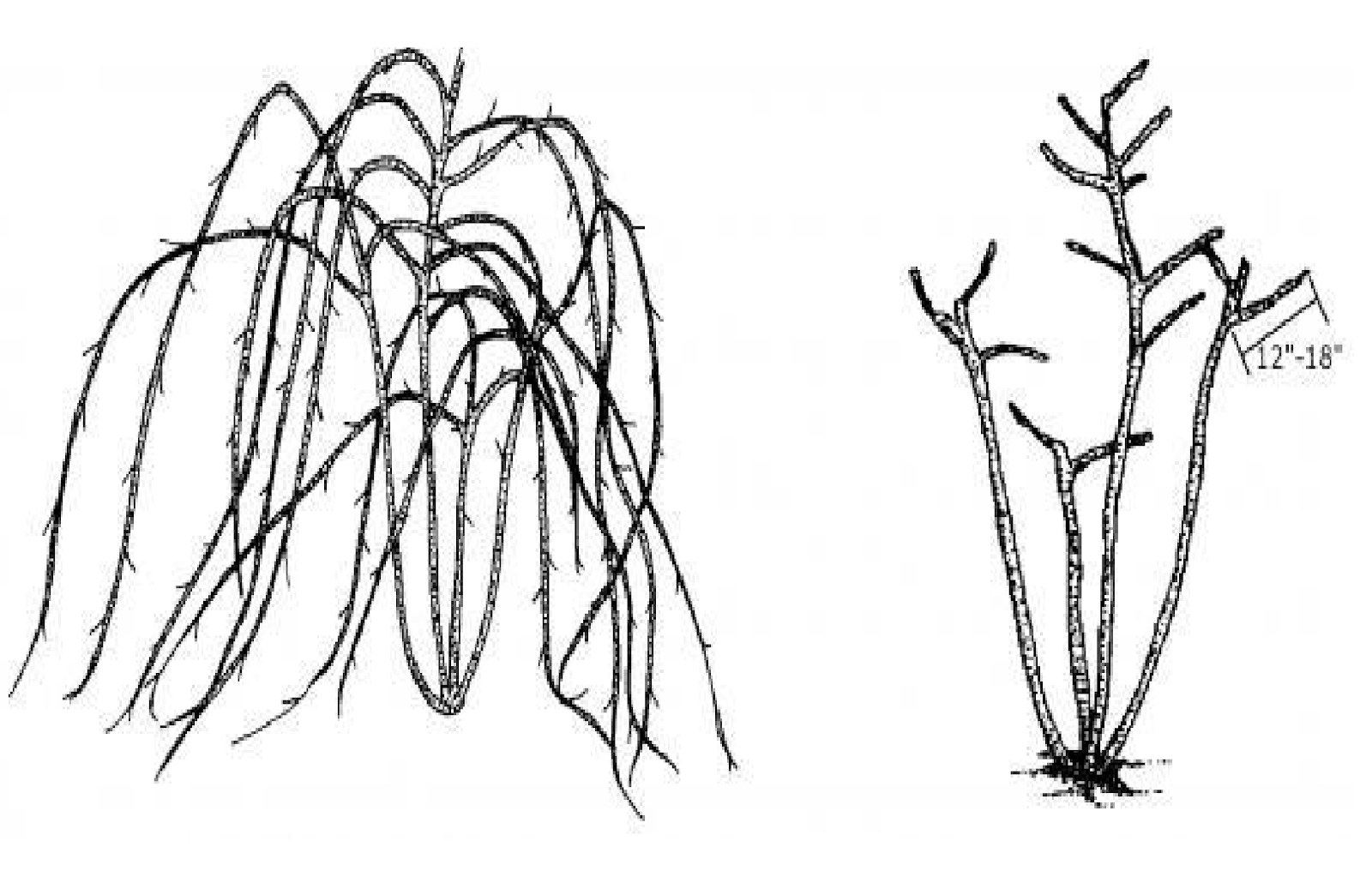
Cutting should be done with one-handed pruning shears or lopers, which will best reach the bases of the shoots to be cut. Drying of the wound surface is fastest if the shoots are cut so that the cutting surface is straight and small. Delicate and out-of-line shoots can also be removed.
After cutting, it is advisable to root the rows of raspberries, as raspberries will not be able to compete with weeds. The growth of raspberries occupied by perennial weeds weakens and the yield decreases. The rows are carefully weeded so that the peel of the shoots and the low root system of the raspberry are not damaged. It is a good idea to apply bark crumbs or wood chips in rows to prevent weed growth.
Harvesting – For the best flavor and texture, harvest your raspberries when it is dry and cool – when it’s not raining, and ideally after the heat of the midday sun has passed. As with many bush berries, the harvest time extends over a longer period of time. Each ripe fruit should have a deep red, black, purple or yellow color, this is also depending on the variety. When your raspberries are ripe depends on whether you have planted summer raspberries, autumn raspberries or so-called two-timers.
Summer raspberries: The main season for summer raspberries is from June to July. Occasionally, fruits continue to ripen until August.
Autumn raspberries: The harvest season for autumn raspberries begins in August. Depending on the variety, you can continually harvest new fruits until the first frost.
Two-timer raspberries: These raspberries bear twice a year. The first time they are harvested from June, the second harvest season begins in August.
Storing raspberries and preserve them – The raspberry is a typical summer fruit. Those who do not want to forego the sweetness of their own raspberries in the colder months of the year. here included a several methods of storing and preserving:
Freezing – Raspberries are great for freezing. Everyone knows the big bags or boxes from the deep-freeze department that are filled to the brim with the sweet fruits. Before freezing, however, you should wash and pre-sort your raspberries. Remove all fruits that show signs of pests or mold. After washing and sorting, the raspberries should drain thoroughly and dabbed with a kitchen towel so that unnecessary ice crystals do not form when they freeze. Depending on what the raspberries thawed again at a later point in time will be used for.
Preserving – Like almost any fruit, the raspberry is ideal for preserving. Whether as whole fruit in your own syrup or processed as jam or jelly: the raspberry offers a whole range of possibilities. If you want to boil down whole raspberries, you should only use a little preserving sugar and add the remaining sweetness over normal sugar. When cooking raspberry jam, however, you should use plenty of preserving sugar to achieve a spreadable consistency.
Raspberry jam recipe without added pectin
Ingredients:
9 cups crushed raspberries
6 cups sugar
Yield: About 7 or 8 half-pint jars
Procedure: Sterilize canning jars in a water bath canner. Wash raspberries before crushing. Combine raspberries and sugar. Bring gently to a boil, stir until sugar dissolves. Once sugar is dissolved, cook rapidly to, or almost to 220oF, depending upon whether a firm or soft jam is desired. As mixture thickens, stir frequently to prevent sticking. Remove from heat and fill hot jam into hot sterilized jars, leaving ¼-inch headspace. Wipe rims of jars with paper towel; adjust two-piece canning lids. Process in a boiling water canner.
Note: If seedless jam is preferred, crushed raspberries may be heated until soft and pressed through a sieve or food mill; then add sugar and proceed as above.
—-
Propagation by layering – Lowering individual shoots is a tried and tested method of propagation for many plants and also works very well with raspberries. It is possible all year round, provided that there are sufficiently long young shoots. You bend individual shoots downwards in an arc and cover a section of shoots with soil after you have fixed it in the ground with a tent hook. If the shoot bears leaves, these must first be removed in the corresponding area, otherwise fungal infections can easily develop through contact with the soil. The lowered shoot forms new roots at the deepest leaf node. It can be cut off from the mother plant in autumn or spring if there is sufficient rooting and replanted at the desired location.
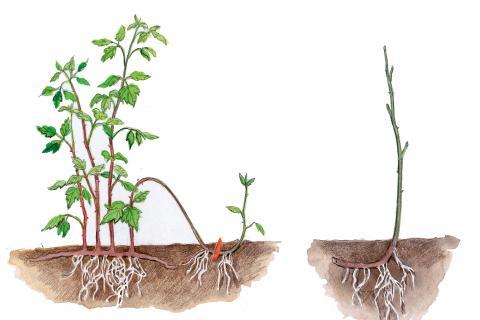
Figure 4
Propagation by cuttings – By cuttings raspberries can easily multiply. In addition, this method is very productive, as you can grow several young plants from one shoot. Head and partial cuttings with at least two leaves are obtained from the new, only slightly woody shoots in early summer and placed in a nutrient-poor growing medium. They form their own roots in a covered seed tray in a warm, light place within two to three weeks and can then be planted directly in the bed. Cuttings can also be cut from the harvested two-year-old canes in autumn. The pencil-length pieces should end with one eye at the top and bottom and are best wrapped in bundles in boxes with moist humus soil until spring, stored in a shady, sheltered place outdoors and kept evenly moist.
Phytophthora
The most important disease in raspberries is Phytophthora (red root rot), which leads to reduced growth of new shoots and, in the long term, to death of the cane.
Symptoms: include a general lack of vigor and a sparse plant stand. Externally healthy stems can suddenly decline and collapse in late spring or summer. In such cases, the leaves may initially turn yellow, red or orange, or they may begin to scorch around the edges.
Prevention and Control: Since there is no pesticide against root rot in raspberries, we recommend measures to prevent it from spreading and to get the infestation under control. You should dig up infected plants with their roots as soon as possible and dispose of them in the residual waste. Please do not place the plants on top of the compost, as spores of the fungus may be retained during composting.
The fungal spores can survive in the soil for years. Therefore, raspberries should not be planted for a few years on areas that are already infested. In another place, as far as possible from the infected soil, you can plant raspberry varieties that are highly resistant to root rot, for example the ‘Rubaca’ variety.
Preventing waterlogging is particularly helpful for prevention. Therefore, you should avoid compact or very moist soils as a location. In addition, cultivation on embankments is possible, which also reduces waterlogging.
Rod disease
Another notable disease is rod disease, which can be traced back to several pathogens. While Phytophthora can only be prevented by an optimal soil structure, the rod disease can be combated with fungicides.
Symptoms: The rod disease, also known as rod death, can be recognized from early summer by purple to black spots on new shoots. The spots often arise first in the leaf axils and become larger and larger over time and can develop into strips that extend over the entire shoot. In late summer, the entire shoot is usually affected, the bark looks black and shines silvery in the light. The leaves of infected branches turn yellow more quickly than on healthy shoots. In addition, the bark begins to peel off the wood.
Prevention and control: In order to specifically combat the various pathogens causing rod disease, it would be necessary to identify the exact pathogen. Unfortunately, this is usually not possible, which is why we advise against the use of pesticides for rod diseases. You should remove infected rods as soon as possible and dispose of them in the general waste to slow down further spread.
As a preventive measure, we recommend that you avoid too dense stands. A good row spacing is 2.5 meters, there should be at least 50cm space between the plants. Regular weed control also contributes to a well-ventilated stand. In all grooming activities, it is important to avoid injuring the rod. If you cultivate the raspberries with a climbing aid, you should therefore make sure that the rods are not injured.
A need-based fertilization will help you to keep the raspberries healthy. We recommend that you ensure a good supply of potassium and phosphorus when fertilizing.
Virus diseases – That can cause dwarfism or produce dwarf crops are another risk in commercial cultivation.
Pests – on the raspberry are aphids, raspberry flies, raspberry gall flies, raspberry beetles and spider mites.
Prevention and control: Spray infested plants with a blast of water from the garden hose, making sure to target the underside of the leaves. This method removes and kills insects on the surface of the leaves and fruit. It is most effective for aphids, some mite species and thrips, which are all pests of raspberries.
Raspberry have the potential to provide multiple benefits such as: They can be main ingredient in cake, pies, ice cream and canning, that can be eaten in breakfast, lunch, dinner and dessert. From raspberry leaves can be made excellent tea, it blossoms volume makes it an ideal single pollen honey, it can be also widely used as a medical medicine that may protect against diabetes, cancer, obesity, arthritis and other conditions and may even provide anti-aging effects, along with various other benefits:
Food uses – Raspberries are moderately rich in fruit acids and sugars, especially in sunny summers. Raspberries are rich in minerals and trace elements, especially magnesium and manganese. Raspberries are good when used fresh as well as juices and jams. They are also used to make syrups, wines, liqueurs and vinegar. Raspberries are also used in confectionery and cosmetics.
Raspberry leaves can be made into tea and can be collected already in buds in the spring among salads and as a decoration for dishes. Young dried spring shoots can also be utilized. Tea leaves are used either fresh, dried or ground. The grind is very suitable for raspberries and brings out new aromas. The leaves contain 400mg / 100g of vitamin C.
Medicinal uses – The raspberry leaves are used in folk medicine like the leaves of blackberries, because of their tannin content as a tea for mild diarrheal diseases, to gargle for inflammation in the mouth and throat, and more rarely for washing with chronic skin diseases. Fermented raspberry leaves can be reminiscent of the taste of black tea, so they are often found in home tea blends. The syrup is used to improve the taste and color of medicines, since ancient times it has been given (diluted) as a thirst-quenching drink for people with a fever. In naturopathy, fruits, leaves, flowers and roots are used. For example, the berries are boiled or eaten raw, or the various parts of the plant are used as teas. The effects of the plant range from anti-inflammatory, blood-purifying, astringent to calming, antipyretic, diuretic and diuretic. It is used, among other things, for a weakened immune system, rheumatism, sore throat, mouth ulcers or digestive problems. Raspberry leaf tea can have a cycle- regulating effect and reduce menstrual cramps and an existing premenstrual syndrome (PMS).
Vitamins per 100 grams
| Vitamin B1 | Vitamin B2 | Vitamin B6 | vitamin C | Vitamin E. |
| 0.02 mg | 0.05 mg | 0.08 mg | 25 mg | 0.91 mg |




